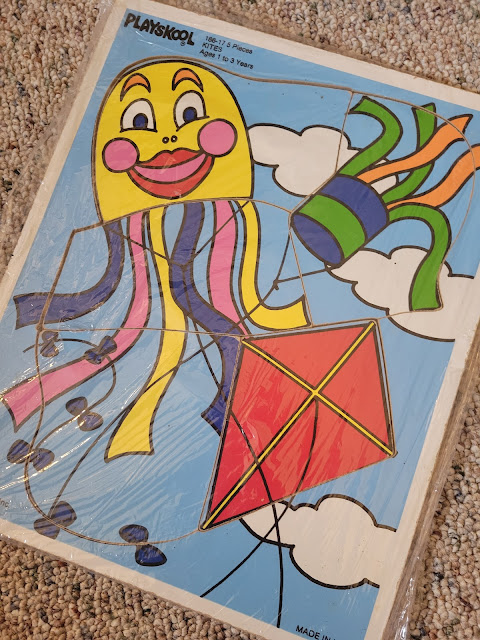Shhh, be very, very quiet.
I'm posting here again though it has been y-e-a-r-s, and you really don't want to make any sudden movements or startle me in some other way.
You see, I was a kindergarten whisperer for twenty-five years, and I blogged here regularly for about a decade... or decade-ish. After finally discovering the perfect master's program for myself, I decided it was time to not just teach kindergarten but a-l-l of the kindergarteners (and first, second, third, fourth, fifth, and sixth-graders) as my school's librarian. My third year as a librarian (why-bearian, lye-bearian) begins in another month, and just as I enjoyed my summers "off" as a kindergarten teacher, I've found that June and July remain essential periods of rest for my well-being.
Now surrounded by books and readers all day long, you might think that my quarter-decades-worth of summertime thrifting and yard saling for my classroom would be behind me, but oh no, no-no-no, that hasn't been the case. I certainly buy books on a much larger scale than I did before, but I've also continued to grab vintage puzzles and manipulatives for library centers every time I come across cute designs or extras of items that have been popular with students of all ages. Sturdy puzzles were very popular last year with kindergarten, first, and second graders when visiting the library, as more traditional stiff cardboard puzzles got mangled with force or picked apart by students of all ages as they tried to understand how pieces were made.
Wooden Playskool puzzles have been showing up in antique malls around here lately and so many have been in great shape without chips, flakes, or color fade, for roughly $4-$8 each. Since most feature nursery rhyme characters, toys, food, vehicles, buildings, and other people and animals, it's easy to align them with stories and non-fiction content. Since I never expected my Super Stars to sit for huge chunks of time with idle hands, I went ahead and brought all of my kindergarten puzzles and builders into the library when I made the move and quickly discovered that students of all ages appreciated being able to collaborate and create while building their appreciation of books and all of the worlds and information contained within them.
The condition of these puzzles is important, as is the date of when they were manufactured since truly vintage painted toy items likely contain lead. Chipped and flaking paint on old toys makes them unsafe for play or regular handling. You can test the paint on these items using kits that many new homeowners and house-flippers find useful, such as this one:
Last year I encountered several students of varying ages who had no idea how to put puzzles together again after flipping the board over and emptying the pieces onto the floor which honestly alarmed me, as puzzles help children develop their memory skills while they test ideas, solve problems, develop their fine motor strength and agility, and persevere. Dimensional, solid puzzles are essential tools for young learners in my opinion, and wood holds up for much longer than cardboard or hollow plastic.
Keep your eyes peeled this summer as you visit thrift stores and yard sales, and don't toss, donate or sell every "kindergarten" manipulative if you decide to change gears like I did.







No comments:
Post a Comment
As always, thank you for your comments, tips, suggestions and questions!